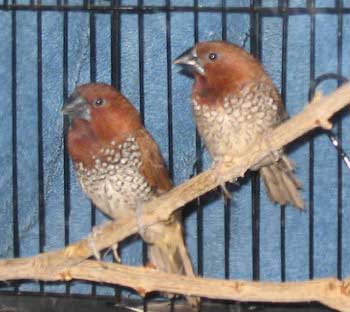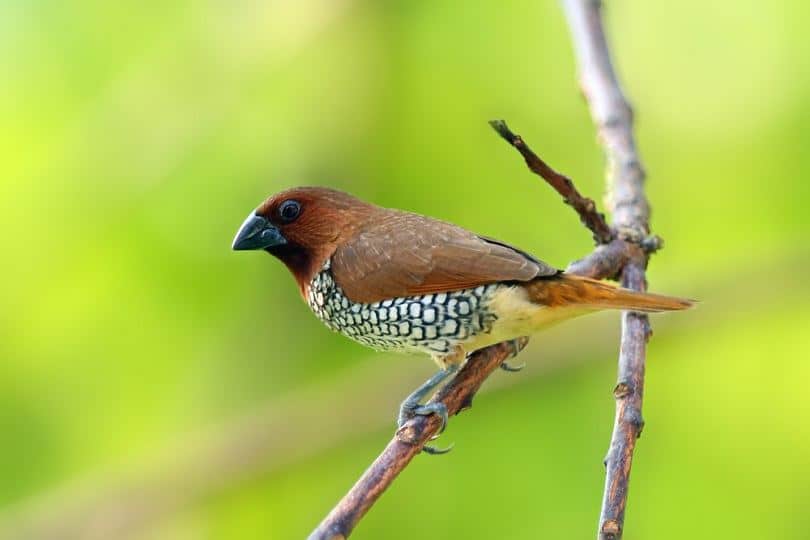
Spice Finches, also called the Nutmeg Mannikins, are excellent for the beginner. Besides being gentle and hardy, they are inexpensive and adjust easily to cage or aviary life. They are easy to keep and will live for many years.
The Spice Finch gather in small groups in the wild. They are very peaceful and sometimes their groups will be mixed with a variety of other small birds. Spice Finches are very hardy and dealers in India have been known to dye this little bird different colors, especially green, and offer them for sale as “painted finches”. This must not be confused with the real Painted Finch (Emblema picta)!
For more information about the care of Finches see:
Guide to a Happy, Healthy Finch
- Kingdom: Animalia
- Phylum: Actiniform
- Class: Elasmobranchii
- Order: Passeriformes
- Family: Estrildidae
- Genus: Lonchura
- Species: punctulata
Scientific name:
Lonchura punctulata Learn more about the Spice “Family”, the Estrildidae Finches here: Finch Families
Description:
Spice Finches reach a size of 4 3/4″ (12 cm). They have a bluish-black bill. The head, throat, and neck are a chestnut brown, going into a chocolate brown on the top and sides of the neck, and usually darker on the head. The under parts are a whitish buff. The breast and sides are a brown with a dark brown scalloped edging to the feathers.
Distribution:
Spice Finches are widely distributed throughout India, Southern Asia, Ceylon, and Malaysia.
Care and Feeding:
Fresh food and water must be provided daily. A good finch seed mix will provide their everyday preference for a variety of millet and grass seeds and is readily available at a pet store. In a separate cup you can offer green foods, such as lettuce, spinach, celery tops, and chickweed. Other supplements include green seeds, sprouted seeds, egg foods, and mealworms. Finch treats of seed with honey, fruits and vegetables are fun for your bird too, as well as nutritious!
Grit with charcoal is essential to aid in digestion and it contains valuable minerals and trace elements. Grit should be provided in a special cup or sprinkled over the bottom of the cage floor. Provide a cuttlebone because the calcium it provides will give your bird a firm beak, strong eggshells when breeding, and will prevent egg binding. The lime in the cuttlebone also aids in digestion.
Offer your finch a bath occasionally by providing a bath dish that is 1″ deep with a 1/2″ of water, or a clip on bath house.
Their nails may occasionally need to be trimmed, but be careful never to clip into the vein as the bird can quickly bleed to death. Bird nail trimmers and styptic powder to stop the bleeding are available at pet shops.
Housing:
Spice Finches do well indoors in a cage, but will need to be in an aviary if you wish them to rear young. Place the cage where it is well ventilated though free from drafts, and against a wall at eye level. It should have good light but be away from doors and windows where direct exposure to sunlight can make it overly warm.
Provide two or three good softwood perches about 3/8″ to 3/4″ in diameter. Tree branches of a similar size also make good perches and will help to wear the claws down naturally. Provide separate dishes for food, water, treats, and grit. Place paper on the cage bottom that can be sprinkled with grit, or use a grit paper.
Spice Finches also do very well in an aviary or a bird room. The screening should be 3/8″ square mesh. Dishes for food, water, grit and bathing water must be included along with perches and nests. Leafy branches, tall grasses and reeds, and dense bushes will make the space more enjoyable for the finches as well as providing nesting materials.
Maintenance
:
Although finches require very little time, a clean environment as well as fresh food and water daily is a must to prevent disease and illness. The basic cage care includes daily cleaning of the water and food dishes. Every two to three days change the paper on the bottom of the cage and sprinkle it with about 1/8″ of fresh grit. Weekly wash and dry the entire cage, including the perches.
Social Behaviors:
Spice Finches are social, peaceful birds. They naturally live in groups and easily adjust to other birds in a spacious aviary.
Handling/Training:
Finches are simply enjoyed for their antics and play rather than training. When you need to handle your finch to examine it or clip it’s nails, place your palm on it’s back and wrap your fingers around the bird with your thumb and forefinger on either side of it’s head.
Activities
:
Spice Finches are always active and energetic.
Breeding/Reproduction:
Spice Finches are not too difficult to breed in an aviary and there you can house them in groups. However, they generally will not breed in a cage. It is difficult to tell the differences in the sexes, but the male will perform a courtship dance to his mate. They like voluminous nests and will build them using nesting materials such as long grass leaves, plant stems and coconut fiber. They will line the nest with soft materials such as moss and feathers.
The female will lay a clutch of 3 to 7 eggs and will need to have lots of green seeds, sprouted seeds, greens, egg food, and mealworms to feed the hatchlings.
Potential Problems:
Spice Finches are very hardy birds and almost all illnesses can be traced to improper diet, dirty cages, and drafts. A balanced diet and plenty of exercise will prevent most illnesses. Know your bird and watch for real drastic changes as indications of illness.
Some signs of illness to be aware of are droppings that are not black and white, feathers that are ruffled, lack of appetite, wheezing, and acting feeble and run down.
Some of the common illnesses and injuries your finch could contract are broken wings or legs, cuts and open wounds, overgrown beaks and nails, ingrown feathers, feather picking, confinement cramps in the legs from a cage that is too small, weight loss, heat stroke, shock, concussion, egg binding, diarrhea, mites, colds, baldness, scaly legs, sore eyes, tumors, constipation, and diarrhea.
First you can try and isolate the bird in a hospital cage where you cover all but the front of the cage and add a light bulb or heating pad to keep the interior of the cage at a constant temperature of 85 degrees Fahrenheit. Remove all perches and put food and water dishes on the floor. If you don’t see improvements within a few hours, take the bird to an avian veterinarian for diagnosis and treatment.
Availability:
Spice Finches are readily available in the pet industry and are very inexpensive little birds.
Featured Image Credit: Karel Bartik, Shutterstock
